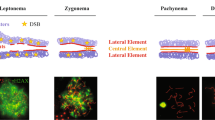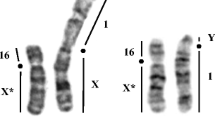Abstract
THE Lyon hypothesis1 was constructed on genetical evidence derived from observations of sex-linked variegation of coat colour in the mouse. Within the framework of this hypothesis, late DNA synthesis and genetic inactivity of the same X chromosome are considered strictly related phenomena. Thus information about the chronology of DNA replication in structurally abnormal X chromosomes is relevant to the study of the genetic activity of mammalian sex chromosomes. So far, such information is available only for two mammalian species, mouse and man. In human females, structurally abnormal X chromosomes, such as deficiencies, duplication/deficiencies or rings, were found to be consistently late-replicating compared with the normal X chromosome2. The same applies to a presumptive X-autosome translocation3. In the mouse, two cases of X-autosome translocations have been studied cytogenetically, with contrasting results. In females heterozygous for Searle's translocation (T16H), in which part of the X chromosome is translocated on to an unidentified autosome, the sex-linked variegation is suppressed. Lyon et al.4, by the appropriate genetic tests, showed that the translocated X was consistently active while the normal X was inactive in all cells. Ohno and Lyon5 later reported that the normal X of heterozygous females carrying the translocation showed positive heteropycnosis in 90 per cent of somatic prophases.
Similar content being viewed by others
References
Lyon, M. F., Nature, 190, 372 (1961); Russel, L. B., Science, 133, 1795 (1961); Gruneberg, H., J. Embryol. Exp. Morphol., 16, 569 (1966).
Fraccaro, M., and Lindsten, J., in Cytogenetics of Cells in Culture (edit. by Harris, R. J. C.) (Academic Press, New York, 1964).
Mukerjee, D., and Burdette, W. J., Nature, 212, 153 (1966).
Lyon, M. F., Searle, A. G., Ford, C. E., and Ohno, S., Cytogenetics, 3, 306 (1964).
Ohno, S., and Lyon, M. F., Chromosoma, 16, 90 (1965).
Ohno, S., and Cattanach, B. M., Cytogenetics, 1, 129 (1962).
Cattanach, B. M., and Isaacson, J. H., Genetics, 57, 331 (1967).
Evans, H. J., Ford, C. E., Lyon, M. F., and Gray, J., Nature, 206, 900 (1965).
Mukherjee, B. B., and Sinha, A. K., Canad. J. Genet. Cytol., 5, 490 (1963); Gartler, S. M., and Burt, B., Cytogenetics, 3, 135 (1964).
Gustavsson, I., Nature, 211, 865 (1966).
Author information
Authors and Affiliations
Rights and permissions
About this article
Cite this article
GUSTAVSSON, I., FRACCARO, M., TIEPOLO, L. et al. Presumptive X-Autosome Translocation in a Cow : Preferential Inactivation of the Normal X Chromosome. Nature 218, 183–184 (1968). https://doi.org/10.1038/218183a0
Received:
Issue Date:
DOI: https://doi.org/10.1038/218183a0
- Springer Nature Limited
This article is cited by
-
Translocation X sur autosome et replication tardive
Human Genetics (1975)
-
Abnormal X chromosomes in man: Origin, behavior and effects
Humangenetik (1974)
-
Directed Genetic Change Model for X Chromosome Inactivation in Eutherian Mammals
Nature (1971)
-
Early DNA Replication Patterns of the Normal Sex Chromosomes and a Presumptive X-autosome Translocation in Cattle (Bos taurus L.)
Nature (1971)
-
Timing of DNA replication of translocated Y chromosome sections in somatic cells of Drosophila melanogaster
Chromosoma (1969)





